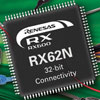

Renesas announced the release of a second selection of products in its RX family, which forms the core of the company’s microcontroller business.
The new RX62N and RX621 product groups comprise a total of 16 models and 31 individual products.
Aimed at applications in the fields of building management, industrial automation systems and office equipment, the 32-bit MCUs incorporate a varied selection of communication functions. In addition to conventional serial communication functions, the RX621 series boasts USB 2.0 Host, Device and CAN interfaces, while the RX62N series has an Ethernet controller, USB 2.0 Host, Device and optional CAN interface. The two groups are pin-compatible, allowing customers to choose the group that best matches their products and to reuse existing development resources.
The Ethernet MAC (media access control) module used has a proven track record in the SuperH Family of 32-bit RISC MCUs, and supports the MII (media independent interface) and RMII (reduced media independent interface) defined under the IEEE802.3u standard, enabling 10 Mbps and 100 Mbps Ethernet LAN connections. 176-pin product versions have two USB channels, each of which can operate independently using separate function settings.
The new MCUs are built around the RX CPU, which delivers processing performance of approximately 1,65 MIPS/MHz and achieves performance of 165 MIPS when operating at 100 MHz. Code efficiency is more than 30% better than that of earlier Renesas products, resulting in more compact program object code. This means smaller capacity on-chip Flash memory is sufficient, enabling lower overall system cost.
In addition to the performance of the RX CPU provided by its Harvard architecture, which allows instruction read operations and data write operations to be performed simultaneously, the system bus configuration of the RX62N and RX621 series separates the CPU bus from the other bus masters, such as the direct memory access controller (DMAC), data transfer controller (DTC), and Ethernet controller DMAC. This enables high data transfer rates for the Ethernet, USB and other interfaces.
The CPU meets a core current performance target of 0,03 mA/MHz, giving the MCUs a typical current consumption of 50 mA when operating at 100 MHz. There are also four power-down modes, allowing designers to improve overall system power efficiency.
The chips have maximum 512 KB of high-speed Flash memory, which achieves single-cycle access at 100 MHz. They also have 32 KB of data Flash memory with a background operation (BGO) function that enables data to be written at the same time a program is executing. This functionality allows data writes without slowing program execution, making it ideal for backup applications and the like.
The RX family meets demand for enhanced timer functions with multifunction timer pulse units (MTUs), an independent watchdog timer (IWDT) and a real-time clock (RTC). These enable mobile motor control and provide improved flexibility. The resolution of the A/D converter has been boosted from 10 to 12 bits, and the conversion speed has been boosted to 1 μs.
For more information contact Marinus Rudman, Hi-Q Electronics, +27 (0)21 595 1307, [email protected], www.hi-q.co.za
| Tel: | +27 21 595 1307 |
| Email: | [email protected] |
| www: | www.hi-q.co.za |
| Articles: | More information and articles about Hi-Q Electronics |

© Technews Publishing (Pty) Ltd | All Rights Reserved